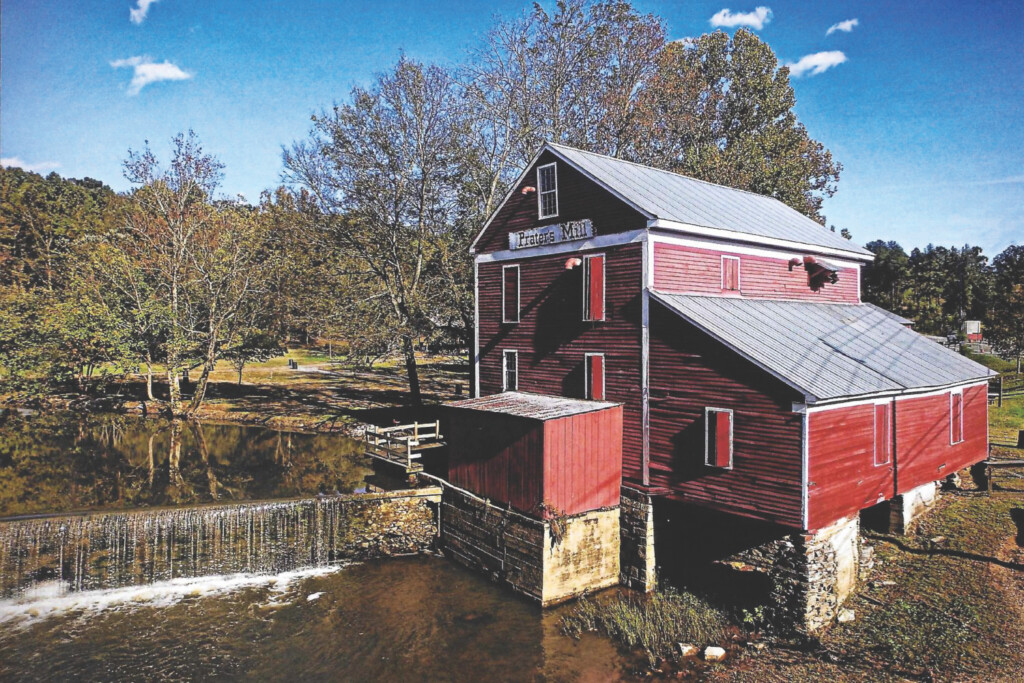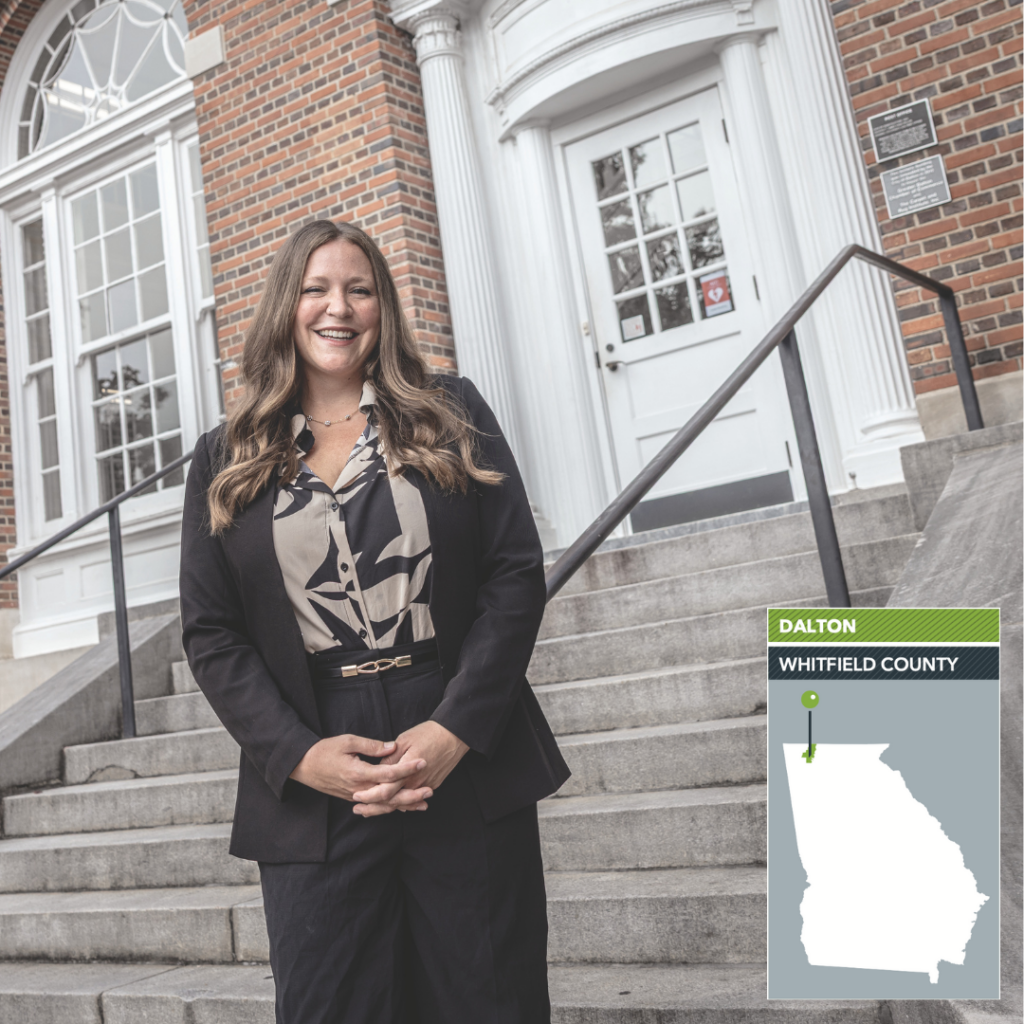Dalton | Whitfield County: Manufacturing, Housing and Revitalization
Deciding on Dalton.

Attracting Industry: Carl Campbell, executive director of the Dalton-Whitfield Joint Development Authority, Essentia Protein Solutions plant: photo Kevin Garrett.
You won’t find tall office towers crammed with workers in cubicles in Dalton or Whitfield County – this community prides itself on making things that people use. Known as the “Carpet Capital of the World,” this Northwest Georgia county recently added another “best of” title to its list of accolades as home of the largest manufacturer of solar panels in the western hemisphere.
“We’ve been in the manufacturing business for over a century,” says County Administrator Robert Sivick. “Our economy is heavily manufacturing-based, and the 800-pound gorilla is our flooring manufacturers, including Shaw, Mohawk and Engineered Floors.”
Dalton and Whitfield County have long been a jobs center, according to Carl Campbell, executive director of the Dalton-Whitfield Joint Development Authority.
“I grew up here, and we’ve always had a lot of jobs here,” Campbell says. “About 30,000 people come to Dalton every day for their jobs. We pull from about 15 counties and a 50-mile drive radius.”
Campbell says he believes Dalton “punches above its weight class” when it comes to attracting new industry. In fact, the community recently landed a one-two punch with back-to-back expansion announcements from Qcells, which manufactures solar panels for residential, commercial and solar farm customers.
“They announced an expansion, which was essentially phase two, in the fall of 2002, and in early 2023, they came back and said, ‘Hey we want to add phase three to phase two.’ They had an expansion announcement and then it got bigger.”
South Korean-owned Qcells is investing more than $2.5 billion to expand its solar module manufacturing operations in Georgia, including its third facility in Dalton and a new facility in Cartersville. In Dalton, Qcells’ $379 million investment will bring about 1,000 new jobs, Campbell says.
“These jobs are already being hired right now,” he says, adding that he expects the expansion to be up and running by now. “Prior to the expansion they were making about 14,000 solar panels a day, and with the expansion they’re going to approximately triple that capacity.”
When it’s all said and done, Qcells will employ between 1,600 and 1,700 workers, Campbell says.
“That will make them the fourth- largest manufacturing employer that we have,” he says. “No. 1 is Shaw, No. 2 is Mohawk and No. 3 is Engineered Floors.”
Across the street from Qcells in the Carbondale Business Park, Essentia Protein Solutions is building a new broth manufacturing plant. The plant represents an $80 million investment and will create 80 jobs, Campbell says.
“You’re not going to find their products on the shelf at Publix, but in other products that you will find on the shelf,” he says. “Food is typically recession-proof, so we felt like they would be a value-add for our community.”
More Than Manufacturing

Multitasking Manager: Whitfield County Board of Commissioners Chair Jevin Jensen at Riverbend Park soccer fields: photo Kevin Garrett.
Whitfield County Board of Commissioners Chair Jevin Jensen says with the expansion of Qcells and the addition of Essentia, the county continues to flex its muscles as a manufacturing hub. But there’s more to the area than just good jobs.
“Whitfield County has opened two new parks in the last year,” he says. “A hiking, biking and Civil War historical park with over 1,000 acres available for all residents, Rocky Face Ridge Park is one of the largest county-managed parks in Georgia. We also opened our new Riverbend Park with a FIFA-certified turf soccer stadium to ensure we continue our dominance at the state level. Whitfield County had three state-champion high schools for 2023.”
Riverbend Park also includes four turf baseball fields and two indoor basketball courts, plus pickleball courts.
Jensen says Whitfield County also has an eye on the future with the completion of its 24/7 digital courthouse, which allows full access to county records stored in the cloud and streaming video of court and board of commissioners meetings. Additional FIFA soccer fields are being constructed, and expansions at a library, the historic Prater’s Mill visitor center and fall festival are all in the works.

Expansion Announcement: Qcells is enlarging its solar module manufacturing operations and adding jobs: photo Jonathan Selden.
Meanwhile, according to Sivick, the industrial park is “just about full at this point,” leading the county to invite its neighbor to the east, Murray County, to join the city-county joint development authority. The partnership gives Murray County officials access to the economic development expertise of the Dalton-Whitfield JDA, and in return the JDA gets access to Murray County’s larger supply of flat, developable land, Sivick says.
“Economies care nothing about political boundaries,” he says. “What’s good for Murray County is good for Whitfield County.”
Housing Starts

Nibbles and Libations: The Gallant Goat, an upscale craft cocktail bar, sits below 18 apartments in the historic Belk-Gallant building: photo contributed.
Sivick says, in local government “you’re either growing or you’re dying, and we’re growing.” But that growth doesn’t come without growing pains. A severe housing shortage, which had its start in the Great Recession when builders essentially stopped constructing new housing, persists even as city and county leaders are working hard to overcome it.
“Right now we have thousands of units, single-family and multi- family, that will be coming online,” he says, “but that is still only going to make a dent in the housing shortage problem.”
First out of the gate is a multiuse development called Patterson Farms, which will include about 500 single-family homes, townhomes and condos on land that was once a horse farm. Further north on Cleveland Highway, Camden Farms will eventually have between 1,300 and 1,600 homes built on land that measures nearly a square mile. Both developments will have commercial space and upscale retail and dining options, according to Sivick.
“I think they have almost 100 homes that have already sold [in Patterson Farms],” he says. “They sell the homes before they are even finished building them because the housing shortage is so dire here. [With] Patterson Farms, in fact, the county drew a tax allocation district providing credits to the developers for walking trails and an amphitheater. We also have a number of large apartment buildings that are coming online.”
Intown Living

Preserving Heritage: Prater’s Mill, built in 1855, is a historic site that relies heavily on revenue from the annual county fair: photo contributed.
While the county works to overcome its housing shortage, intown living is proving popular. Bob Caperton, president and managing partner of Dalton’s Barrett Properties, was among the first to envision and create living spaces downtown when he converted the former Belk-Gallant building into 18 apartments above a space that would become the Gallant Goat, an upscale craft cocktail bar.
Though the units were originally intended to be available to the public, Shaw brokered a deal with Caperton for 20 of the carpet manufacturer’s trainees to be housed there, Caperton says. (Two of the 18 apartments are two-bedroom units.)
“Before, the trainees stayed four or five miles north of town,” he says. “This lease symbolized a commitment to the community and Shaw’s desire to be more involved in downtown. It’s a great statement by Shaw, and I think it’s very good for their employees who can walk to Burr Park, to Cherokee Brewing [and Pizza], to Dalton Brewing, to Crescent City Tavern.”
According to Caperton, Shaw is involved with two additional housing projects downtown, bringing the number of management trainees living there close to 50.
New restaurants, breweries, retail and housing have all helped to breathe new life into downtown, says Dalton Mayor David Pennington.
“For about a decade we’ve been very intentional about rebuilding our downtown, and now our downtown after 6 o’clock is really happening seven days a week,” he says. “There are big concerts at Burr Park through the summer and into the fall that are attracting thousands to downtown, which we’ve never had before.”
A Dalton native, Pennington remembers when the downtown buzzed with shoppers – up until 6 o’clock. Now, he notes, “We have as many people downtown at night as we used to have during the day.”
The mayor says a new 41-room boutique hotel, The Carpentry, which is expected to open this year, adds to Dalton’s roster of amenities; he believes it will help draw tourists off I-75 into downtown.
“There are a lot of [hotel] rooms on the interstate, but hopefully, this will bring more people into downtown,” Pennington says. “I think once they see the downtown, they won’t just stay the night on their way to Disney World, but maybe now they’ll stay two nights.”
And it’s not just downtown benefiting from redevelopment efforts. According to Pennington, the East Morris Street corridor has been “completely revitalized” thanks to local entrepreneurs.
“These small business owners are risk-takers,” he says. “A dying district has now been completely revitalized thanks to the Latino businesses on that street.” The Latin American Association also has an office on Morris Street.
Building a Unified Community
There are a lot of moving parts when it comes to keeping Dalton growing and moving forward, according to Jason Mock, president and CEO of the Greater Dalton Chamber of Commerce.
“The Greater Dalton Chamber has done some great work over the last year,” Mock says. “Just like any community we have challenges, but at the end of the day what’s great about our community is we’re stepping up together and we’re engaged in the work. We’re coming together and facing them together as a business community, as entrepreneurs and as citizens. The work we do today is the work that is going to pay dividends 20, 30 years down the road.”
That work is guided by Believe Greater Dalton, a strategic plan launched by the chamber in 2018 that is focused on six initiatives: housing, education, downtown, entrepreneurship, economic development and community pride.

Strategic Plan: Believe Greater Dalton Executive Director Allyson Coker at the chamber of commerce: photo Kevin Garrett.
The plan proved so successful that earlier this year, the chamber launched the 2.0 version, says Believe Greater Dalton Executive Director Allyson Coker.
“Believe Greater Dalton was a five-year strategic plan [that was] privately funded, and by the summer of 2021, we had essentially accomplished all of the tactical recommendations of the plan,” Coker says. “The leadership decided we needed to continue in perpetuity, and we began to update the plan for the next five years.”
A planning committee of approximately 35 government officials and community leaders from the public, private and nonprofit sectors finalized Believe Greater Dalton 2.0 in early 2022, Coker says. It was then time to raise the $3 million it would take to implement the plan over the next five years.
“The new plan was officially launched on March 21 of this year,” she says. “We had a community-wide event, a launch party, which we called the 3, 2, 1 launch party.”
The majority of the plan’s pillars remained unchanged, Coker says, including housing, education, economic development, community pride, and engagement and unity. The focus area of downtown was changed to “revitalization,” as the community looks for ways to replicate the success of its downtown revitalization efforts elsewhere.

Unified Community: Believe Greater Dalton Executive Director Allyson Coker on housing bus tour with city leaders: photo contributed.
“We believe that a greater Dalton will be a unified community where everyone feels welcome, included and engaged in the place they call home,” she says. “The success of the first Believe Greater Dalton plan became a collaborative community-wide connecting point. The framework opened communication across sectors and became a catalyst for change and Believe Greater Dalton has ultimately become a movement – a strategic plan that became a movement that exists to advance our community’s belief in and commitment to a better future for all.”
While Dalton and Whitfield County may always be known first and foremost as the Carpet Capital of the World, it is so much more. Local leaders are rolling out the (proverbial red) carpet for new businesses, industry, residents and tourists alike and inviting them to come see today’s Dalton, while at the same time creating an engaged and unified community for all who call it home.
Local Flavor
A Cultural Celebration

Unifying Event: Whitfield County’s large Latin population celebrates Dia de los Muertos, the Day of the Dead, a traditonal Mexican holiday: photo Creative Arts Guild.
If you are a parent or grandparent, chances are you have seen the Disney movie Coco, probably more than once. The animated feature film shines a spotlight on the Mexican holiday Día de los Muertos, which translates to Day of the Dead, a celebration in which families welcome back the souls of deceased relatives. The holiday is celebrated from Oct. 31 to Nov. 2, the Day of the Dead or All Souls Day.
According to the latest U.S. Census, Dalton and Whitfield County are home to a large population of Hispanic and Latino people, 52.5% and 37.7%, respectively. Each year, the Creative Arts Guild in Dalton hosts a community-wide event to celebrate Día de los Muertos.
“We have a large Latinx community here in Dalton, largely from Mexico, so we wanted to celebrate a tradition that is a part of a lot of people’s lives who live here,” says Amanda Brown, executive director of the arts guild. “Our job in our community is to celebrate arts and culture that is innately a part of who we are as people, and I think that this [celebration] is a piece of culture that’s tied to that.”
The event centers around the building of ofrendas, which are altars to honor, remember and feed deceased family members crossing over from the afterlife on Día de los Muertos. Pictures of the deceased and things they liked in life are placed on the altars, as well as traditional items including Pan de Muertos (Bread of the Dead), sweets and cempasúchil (marigolds) to lead the dead back to the land of the living, Brown says.
“One of our biggest motivations is not just to host a party for the Mexican culture, but to have an opportunity for learning and engaging cultures around us,” she says. “It’s a really unifying event because every single person can relate to losing someone they love.”
Participants can build their own ofrenda on the guild’s outdoor pavilion or place items on a community altar constructed by the guild, Brown says. A committee of community advisors recommends additional activities for the event, which have included traditional smiling skull-face painting for children, a lantern parade, dancing horses and a La Catrina costume contest. Most commonly, this historical figure that symbolizes the cycle of life is represented as a tall, female skeleton who wears a fancy hat with feathers. La Catrina’s male counterpart is El Catrin, Brown says.
“La Catrina is the sacred symbol that represents the afterlife,” she says. “The costumes are beautiful, and the skulls are smiling as an acceptance of mortality and as a symbol that in the afterlife we can celebrate people with love.”










